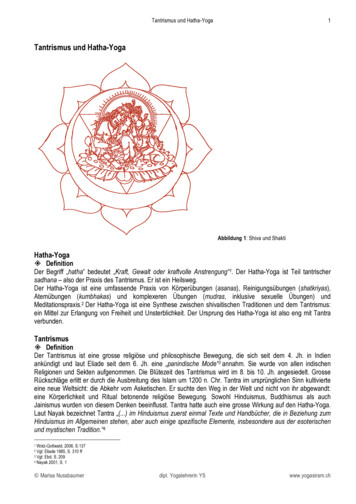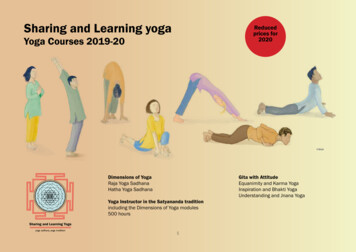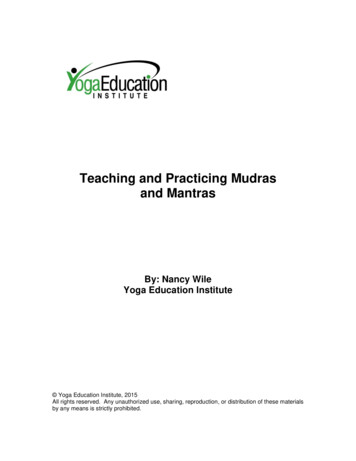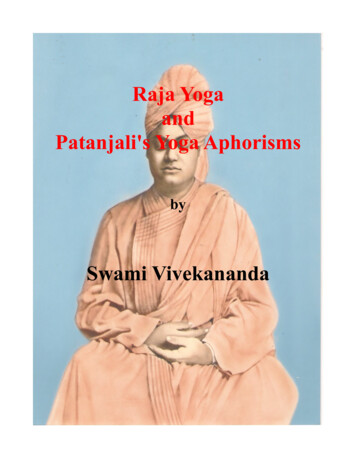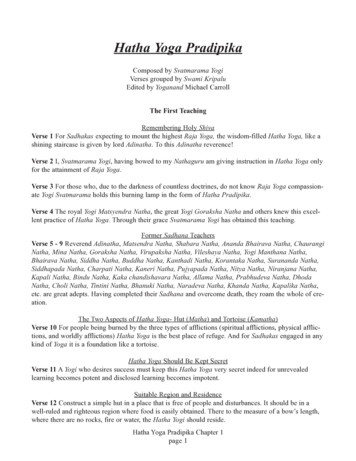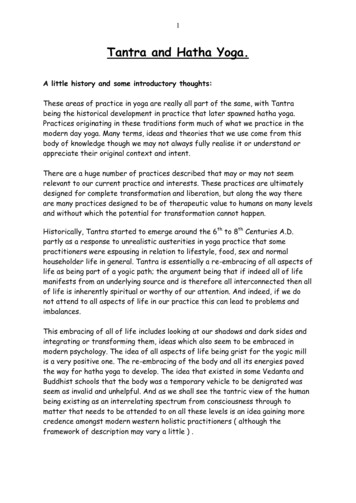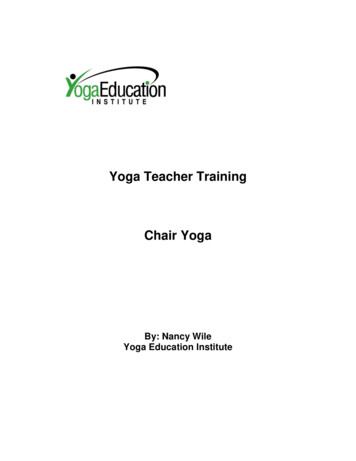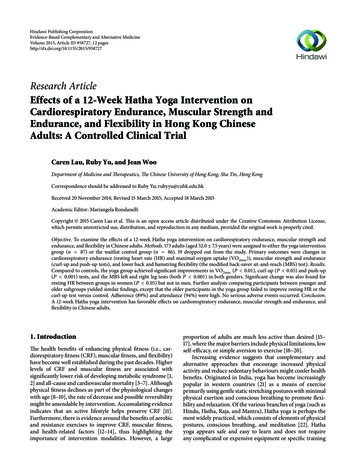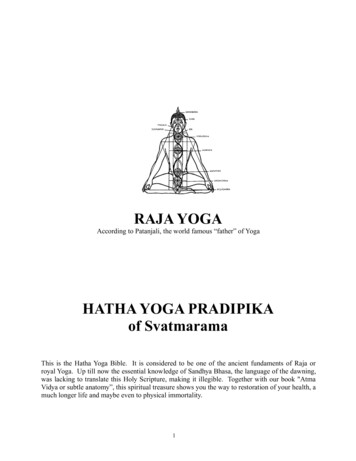
Transcription
RAJA YOGAAccording to Patanjali, the world famous “father” of YogaHATHA YOGA PRADIPIKAof SvatmaramaThis is the Hatha Yoga Bible. It is considered to be one of the ancient fundaments of Raja orroyal Yoga. Up till now the essential knowledge of Sandhya Bhasa, the language of the dawning,was lacking to translate this Holy Scripture, making it illegible. Together with our book "AtmaVidya or subtle anatomy”, this spiritual treasure shows you the way to restoration of your health, amuch longer life and maybe even to physical immortality.1
HATHA YOGA PRADIPIKAof SvatmaramaTranslation of the original text with the Jyotsna commentary of Brahmananda from Sanskrit inEnglish by Srinivasa Iyangar/Tookaram Tatya (1893) on behalf of the Bombay TheosophicalPublishing Fund,Corrected by Prof. A.A. Ramanathan, Pandit S.V. Subrahmanya Sastri and Radha Burnier (1972)of the Adyar Library and Research Center, The Theosophical Society, Adyar, Madras 20, India,Interpretation and comments by Philippe “Ajita” Barbier (1993) of The Raja Yoga Institute,Aalduikerweg 1, 1452 XJ Ilpendam, Holland.Translation of interpretation and comments from Dutch to English by Ben Meier (1995).2
THANKSWe thank the higher powers, which we can call God Shiva, for the great help in the preparation ofthis wonderful and revolutionary version of the “HATHA YOGA PRADIPIKA of Svatmarama”.He has given us the capacity to understand this book of vital interest for mankind.We consider it as our mission in life to pass on this work to all people of good will.With the highest respect also special thanks to Sanat Kumara, our common Father, for his supportand love.Our thanks also to Ben Meier, who has translated so diligently our interpretation and commentsfrom Dutch into English, which has permitted us to offer this book to the whole world.Philippe "Ajita" BarbierTHE RAJA YOGA INSTITUTEFirst editionIlpendam, 1 September 2003.3
CONTENTSpage346THANKSCONTENTSFOREWORD9FIRST CHAPTER12. The Matha14. The first requirements17. Asana's19. - Svastikasana20. - Gomukhasana21. - Virasana22. - Kurmasana23. - Kukkutasana24. - Uttana Kurmasana25. - Dhanurasana26. - Matsyendrasana28. - Pascimotanasana30. - Mayurasana32. - Shavasana33. Asana's van Shiva35. - Siddhasana44. - Padmasana50. - Simhasana53. - Bhadrasana55. Further requirements59. Diet1113152022262931SECOND CHAPTER2. Prana7. Nadi Sodhana Pranayama21. Kriya's24. - Dhauti26. - Vasti29. - Neti31. - Trataka33. - Nauli35. - Kapalabhati38. - Gajakarani39. Pranayama48. - Suryabhedana51. - Ujjayi54. - Sitkari57. - Sitali4
3638414447535660636859. - Bhastrika68. - Bhramari69. - Murcha70. - Plavini72. - Kevala KumbhakaTHIRD CHAPTER5. Mudra10. - Maha19. - Maha Bandha26. - Maha Vedha32. - Khecari55. - Uddiyana Bandha61. - Mula Bandha70. - Jalandhara Bandha77. – Viparita Karani83. - Vajroli92. - Sahajoli96. - Amaroli104. –Shakti Calana85FOURTH CHAPTER5. Samadhi and Prana35. Sambhavi Mudra43. Khecari Mudra54. Samadhi64. Nada70. Arambhavastha72. Ghatavastha74. Paricayavastha76. Nispattyavastha103. A Yogi in Samadhi88REVIEW74767879Note:In the original text there are square brackets. These are additions from Brahmananda. Several ofthese additions have been deleted or corrected. Only the relevant and right ones have been kept.(Ajita)5
FOREWORDRaja Yoga is the complete thousands of years old classical Yoga Training, of which Hatha Yoga is thebasis. First you align your being with Hatha, and then you can develop it further with Raja Yoga.Raja Yoga encompasses all types of Yoga, and is therefore the ideal preparation for any Yoga teacher.The Raja Yoga Institute offers you the well-tried, complete classical Yoga education in royal or RajaYoga structured in the following manner:A thorough 1 year Basic Course for beginners, followed byThe 3-year Teacher's Course for those looking for in-depth knowledge, and concluding withA high class 3-year Master's Course for those with perseverance.In addition to these courses there are several post-grad courses such as a complete Vedanta course(Bhagavad Gita, Upanishad’s, and Brahma Sutra’s), Buddhist-Yoga bridging courses (The voice ofsilence of Blavatsky, Dhama Pada), a finishing touch course (Crazy Wisdom of Padmasambhava), aterminal care course (Tibetan Book of the Dead) and even a practical course Yoga in water.The training is mainly practically oriented, and contains lots of exercises.The theoretical background is based on fundamental Sanskrit scriptures and the methods of the oldseers (Rishi’s), as it has been in true Yoga schools since time immemorial: by realization of certainunconscious aspects every person can discover his true self, and come in contact with higher levels ofconsciousness.The contents may be very orthodox, but we use a special approach, where the emphasis lies onpersonal freedom and making your own choices. Only due to these elements is the growth of yourmind possible. The chance of reaching Self-realization is offered, and maybe even mastery ispossible. Care is taken to create an open, inviting, challenging and participative atmosphere.The combination of the orthodox content and unorthodox approach has rendered an invigoratingresult: Yoga is no longer a rigid discipline, but alive and fascinating. It allows people to developthemselves in a concrete way.The Raja Yoga Institute makes use of the newest discoveries on the field of energy control(Pranayama). After a thorough investigation, namely of the old Sanskrit texts, the hidden meaning hasbeen ascertained of what has formerly been called breath control exercises. It turns out thatPranayama has nothing to do with breathing, as is confirmed by Swami Vivekananda and AliceBailey. Pranayama is a system of techniques, which direct energy mentally.Upon comparing the effects of both approaches it is clear that the effects of the "new" energy controlexercises are impressive, and for the first time, in accordance with the descriptions in the originalscriptures, the Hatha Yoga Pradipika, the Gheranda Samhita and the Shiva Samhita. The bodybecomes more pure, healthier, and stronger, diseases are successfully eliminated, and the quality ofconcentration, meditation and contemplation improve markedly.The complex of techniques, method mentioned above, and our approach have all been tried for years.Dozens of teachers, and hundreds of students guarantee the unique quality of this Raja Yoga Course.6
We believe that a person should set to work on himself systematically if he wishes to develop. Thephysical, moral, emotional, vital, mental, and spiritual powers which one can use in his being areinseparably connected.Growth in any one power alone leads to imbalance of the whole, unless you adapt adequately to thenew situation.There are eight clear, consecutive steps to raise the consciousness slowly but surely to the highestspiritual levels.The ages old Raja Yoga training is based on:1) Moral principes (Yama's):First you stop all existing habits in the areas of violence, lies, theft, unchastity, and desire. By refusing principally, you create time to think and choose a standpoint. You acquire a lot of peace by doingthis.2) Moral ideals (Niyama’s):Consecutively you can lay a solid base in your life by purity, contentment, austerity, studying the Holyscriptures, and surrendering to the Almighty.3) Physical postures (Asana’s):Now you can achieve and maintain physical health, power, and flexibility by physical postures.4) Energy control (Pranayama):Because your energy channels have been cleaned for the most part by the previous exercises, you can,by controlling the flow of energy, achieve a dramatic increase in vitality and power.5) Detachment (Pratyahara):This results in increased sensitivity on sensual and motor levels, so withdrawal or detachmentbecomes a real necessity to keep emotional and mental peace.6) Concentration (Dharana):By concentration of your attention on a single chosen object you increase your mental power.7) Meditation (Dhyana):When no more interruptions occur in your concentration you have reached meditation, true singlemindedness.8) The highest step, contemplation (Samadhi):Finally you acquire true knowledge, together with the awakening of all your occult powers by theincredible power of contemplation, the technique of control over the super consciousness.The Raja Yoga Institute is the only educational facility in the world that indeed offers you the complete, traditional, and tried training to reach contemplation or control of higher consciousness. Only at afew, rare places in the East this training is given as well, but in a much smaller setting.Everybody can join in the training. Only good will is required. The lessons are given daily duringeight weeks each year in Ilpendam, Holland. There is a program for home exercises to go with it.You follow at your own speed, within your capabilities.Ajita is there to help you when you have problems or questions. You better contact him first beforethe lessons start, if you want to participate.You can find all the necessary information about the training course at our site: www.raja-yoga.org.There are many translations and interpretations of the Hatha Yoga Pradipika of Svatmarama. SeveralSanskrit experts have tried to translate this fundamental text of Yoga. The results are mediocre.7
Nobody has been able until now to decipher the hidden meaning of the cryptic text. So it is naturalthat many readers recognize their incapability to understand the content fully.As a result the promise of physical immortality, which is frequently repeated in the text, has beeninterpreted by those ignorants as referring to the immortality of the soul.How is that possible?There are two reasons for this tragic error:1.The Sanskrit experts do not practice Yoga, but they think themselves to be knowledgeable becausethey are the only ones to be able to make some “translation” of the old Sanskrit scriptures;2.The Yoga practitioners have omitted to check the validity of the given “translations”, maybebecause they were impressed by the authority claims of the Sanskrit experts and certainly becausethey were naive amateurs.It is a matter of fact that the Yoga science deserves a scientifical approach. Yoga deserves to bethoroughly checked. No Yoga technique is to be considered as true if the results on the field do notcorrespond with the promised results in the fundamental text.Since 1987 I have elaborated an interpretation of the Hatha Yoga Pradipika mainly trough inspirationduring meditation. Later I have found that this way was called “Sandhya Bhasa”, which means thetwilight language. This is a kind of a symbolic, intuitive language used by Yoga experts in previousages. Thanks to the help of hundreds of students I am now certain: for the first time in the history ofmankind the keys of immortality have been found!The logic of the new interpretation is astonishing, but the results on the field with the practice of thetechniques are absolutely incredible. The results promised in the fundamental text come true!I offer this knowledge to all people of good will, to whom this is meant and belongs to.May this give them more chances to reach liberation.Philippe “Ajita” Barbier8
HATHA YOGA PRADIPIKAFIRST CHAPTER1. I Salute the primeval Lord [Shiva], who taught [Parvati] the Hatha Yoga Vidya, which isas a stairway for those who wish to attain the lofty Raja Yoga.Traditionally, a holy scripture commences with an invocation, a wish or an expression ofgratitude. Its purpose is to create a link with higher powers that enable the creation of such atreatise by engendering inspiration. In this case it is both a salutation and an acknowledgement,enabling an instant link with the god Shiva.Yoga is, according to the old scriptures, of divine origin. Long ago, the god Shiva is said to haveexpounded the Yoga science to his wife, Parvati, on the beach of what is now Sri Lanka. Bychance a fish, Matsya, overheard. The lessons were so formidable that the fish became king, andwas further known as Matsyendra. This fish was the predecessor of man, and the aforementionedMatsyendra was the first yogi.The author indicates that he explains only the first part in this document: the Hatha Yoga part.The sequel, which begins where this one ends, is called Raja Yoga. Apparently at the time therewere enough texts at hand to elucidate Raja Yoga. This is, by the way, an important remark, ifYoga in its complete form is meant to achieve Kaivalya, liberation.2. Svatmarama Yogin, having saluted his Lord and Guru, teaches the Hatha Vidya solely forthe attainment of Raja Yoga.The name of the author, Svatmarama, is made up to these words: Sva or Self, Atma or Soul, andRama, the name of one of the last Buddha’s. This name indicates an advanced yogi, who hasacquired Self-realization. Hatha Yoga is clearly indicated as a preparation for Raja-Yoga.3. To those who wander in the darkness of conflicting doctrines, being ignorant of RajaYoga, the most compassionate Svatmarama Yogin offers the light of Hatha-Vidya.4. Matsyendra, Goraksha, and others knew well the Hatha-Vidya. The Yogin Svatmaramalearned it by their favor.5-9. Shiva, Matsyendra, Shabara, Anandabhairava, Caurangi, Mina, Goraksha,Virupaksha, Bileshaya, Manthana, Bhairava, Siddhi, Buddha, Kantadi, Korantaka,Surananda, Siddhapada, Carpati, Kaneri, Pujyapada, Nityanatha, Nirañjana, Kapalin,Bindunatha, Kakacandishvara, Allama, Prabhudeva, Ghodacolin, Tintini, Bhanukin,Naradeva, Khanda, Kapalika and many other great Siddha's, having conquered time by thepower of Hatha Yoga, move about the universe.In Yoga it is tradition to mention the lineage of the teacher, if the teacher has received hisknowledge from a person. This gives the opportunity to control the quality of that teacher.10. The Hatha Yoga is a sheltering monastery for those scorched by all the [three] types ofpain (tapa). To those engaged in the practice of every kind of Yoga, Hatha Yoga is like the9
tortoise that supports [the world].There are three types of pain: internal, physical or mental; external, caused by people, animals orobjects; and pain caused by subtle things like meteorological conditions (storms, freezing) andplanetary influences.11. The Yogin desirous of obtaining perfection(Siddhi) should keep Hatha Yoga very secret.For it is potent when kept secret and ineffective when [injudiciously] revealed.The term "secret" must be interpreted differently than usual. The science of Yoga is open toeverybody and the yoga teacher does all he can to spread this knowledge. There is nothingmysterious about it. However a practical problem emerges: if you enter a Yoga course halfwaythrough the year, you will understand little or none of it. It's like calculus. The training has astructure, and there are many exercises that help you realize steps. If you miss one, you can'tsimply continue.THE MATHA12. He who practices Hatha Yoga should live alone in a small hermitage (Matha) situated ina place free from rocks, water and fire to the extent of a bow's length and in a virtuous,well-ruled kingdom, which is prosperous and free of disturbances.Being alone is important because the goal in Yoga training is to reach Self-realization. That istherefore a solitary activity, which only later after successful completion will become aharmonizing factor in society.The presence of rocks, water and fire in the immediate vicinity is truly disturbing: the subtleenergy of these elements can, by their dominance, disturb the attempts at controlling your ownenergy and even cause failure. It is obvious that it's quite difficult to worry about spiritual matterswhen your primary necessities of life haven't been fulfilled yet.13. The Matha should have a small door, and should be without any windows; it should belevel and without any holes; it should be neither too high, too low, nor too long. It should bevery clean, being well smeared with cow dung and free from all insects. Outside, it shouldbe attractive with a small hall (Mandapa), a raised seat and a well, and surrounded by awall. These are the characteristics of a Yoga-Matha as laid down by the Siddha’s who havepracticed Hatha Yoga.I keep thinking about Club Med's concept of little huts, an expensive but successful vacationformula.The goal of such a Matha is simply to satisfy fundamental necessities, but by minimal emphasison them, keep the path free for spiritual endeavors.THE FIRST REQUIREMENTS14. Living in such a hermitage [the Yogin], being free in mind of all cares, should practiceonly Yoga all the time, in the way taught by his Guru.Success can only be achieved with a calm attitude, perseverance and clear guidelines.10
15. Yoga fails by the six [causes]--overeating, over-exertion, excessive talk, the observance of[unsuitable] disciplines, promiscuous company and unsteadiness.Habitual eating is eating too much as well. Eat only when you're really hungry. A full time job orstudy can be too demanding. It's preferable to wait till you have graduated or have a part-timejob. Forcing yourself to take a cold shower every morning, or running every morning negativelyaffects your yoga efforts because of the obligation you impose upon yourself. Avoid people witha negative attitude about Yoga. Practicing Yoga now and again, without regularity, also leads tofailure.16. Yoga succeeds by the six [qualifications]--zeal, bold determination, courage, trueknowledge, firmness [of belief in the words of the Guru] and renunciation of company of[unsuitable] people.[To do no harm, to speak the truth, to refrain from taking what belongs to another, topreserve continence, to practice forbearance, to have fortitude, to be merciful, to bestraightforward, to be moderate in diet and to be pure. These ten constitute Yama.]As with everything you endeavor, motivation is important, and determination leads to success.Sometimes when it gets difficult you need quite a dose of courage to see you through. It is alsoimportant to have the right information available, to stick with it, and to dismiss unsuitablecompany from your house.[Austerity (Tapas), contentment, belief in God, charity, worship of God, listening to theexposition of [Vedantic] doctrines, modesty, a discerning mind, Japa (repeating prayers)and sacrifice (Huta) -- these ten constitute Niyama, the experts in Yoga say.]These Yama’s and Niyama’s are comparable to ours, as explained by Patanjali in his Yoga Sutra’s,also published by The Raja Yoga Institute. In conclusion: before doing physical exercises themoral principles and ideals should be practiced.ASANA’S17. Asana’s are treated first, because they form the first stage of Hatha Yoga. Asana’s makeone firm, free from maladies and light of limb.The goal of Asana’s is to engender the free flow of energy in our being. This creates firmness,health and suppleness.18. I proceed to describe some of the Asana’s accepted by the sages as Vasistha and Yoginssuch as Matsyendra.The interesting information here is that the following Asana’s have been specifically selected bythe very respectable seer Vasistha, one of the composers of the Rig Veda, several Purana’s andUpanishad’s and the Yoga-Vasistha. Matsyendra at the other hand is the first human being to havereceived and practiced Yoga.SVASTIKASANA11
19.Having correctly placed both soles of the feet between the thighs and the knees, oneshould sit balanced and straight-bodied. This is called Svastikasana.GOMUKHASANA20. Place the right ankle next to the left buttock and the left [ankle] next to the right[buttock]. This is Gomukhasana, and resembles the face of a cow.VIRASANA21. Place one [the right] foot firmly on the other [left] thigh and the [right] thigh on theother [left] foot. This is called Virasana.KURMASANA22. Press the anus firmly with the ankles in opposite directions and sit well poised. This isKurmasana according to the Yogins.12
KUKKUTASANA23. Assuming the Padmasana, insert the hands between the thighs and the knees; plantingthem firmly on the ground, rise in the air. This is Kukkutasana.UTTANA KURMASANA24. Assuming the Kukkutasana posture (bandha) wind the arms around the neck and lie onthe back like a tortoise. This is called Uttana Kurmasana.DHANURASANA25. Taking hold of the toes with the hands [keep one arm stretched in front and] draw [theother] up to the ear as if drawing a bow. This is called Dhanurasana.13
MATSYENDRASANA26. Place the right foot at the base of the left thigh, and the left foot outside the right knee.Take hold [of the right foot by the left hand and the left foot by the right hand] and remainwith the body turned around [to the left]. This is the Asana described by Matsyendra.27. This Matsyendrasana, [which increases appetite by] fanning the gastric fire, is aweapon that destroys all the terrible diseases of the body; with [daily] practice it arouses theKundalini and makes the Moon steady in men.The Moon means Chandra Bindu. At this point approximately 15 cm above the head Shivaenergy enters and Shakti energy exits the human being.PASCIMOTTANASANA28. Stretch out both the legs on the ground without bending them, and having taken hold ofthe toes of the feet with the hands, place the forehead upon the knees and rest thus. This isPascimottanasana.14
29. This most excellent of all Asana’s, Pascimottana, makes the energy flow throughSushumna, stimulates the gastric fire, makes the loins lean and removes all diseases of men.In my own practice of Yoga I checked the veracity of this Sutra with three subsequent groups of10-15 pupils and a training scheme of one lesson of 1 hour during 15 weeks each time. ThisAsana appeared to be a powerful therapeutical exercise. Even better: this exercise is one of thethree best exercises to heal oneself, as Uttanasana and Salamba Sarvangasana.MAYURASANA30. Plant the hands firmly on the ground and support on the elbows the sides of the navel,[the body] raised in an elevated posture in the air like a rod [i.e. straight and stiff, the feetabove the ground on a level with the head]. This position they call Mayura.31. The Mayurasana cures quickly all diseases like Gulma (enlargement of the glands),Udara (dropsy and other stomach diseases), etc. and overcomes the imbalance of thehumours [namely vatta, pitta, and kapha]. It reduces to ashes [i.e. enables digestion of] allfood indiscriminately taken, kindles the gastric fire and causes to be digested [even] theKalakuta [a terrible poison].As a young boy of 16 I cured myself from various stomach and liver problems with this exercise.My general condition, which was rather bad, changed and my health improved.SHAVASANA32. Lying on the back on the ground [at full length] like a corpse is Shavasana. Shavasanaremoves fatigue [caused by the other Asana’s] and induces repose of mind.Because one is grounded, this means that all the seven Chakra’s are in contact with the ground,the imbalance of some centers can be eliminated, resulting in fitness.ASANA’S OF SHIVA15
33. The Asana’s propounded by Shiva are eighty-four in number. Of those, I shall describefour, which are the quintessence.34. These four, Siddha, Padma, Simha and Bhadra [Asana’s] are the most excellent. Ofthese [four] the most comfortable, Siddhasana, can always be assumed.SIDDHASANA35. The Siddhasana [is now described]: Press the perineum with the base of the [left] heeland place the [other] foot firmly above the penis [or pubis]. Keep the chin steadily on thebreast. Remain motionless with the sense organs under control and with steady vision lookat he spot between the eyebrows. This is called Siddhasana; it throws open the door toemancipation.“Keep the chin steadily on the breast” means Jalandhara Bandha Mudra. This prevents the Shaktienergy to leave you. As a result you obtain as much Shakti as Shiva in your being.The spot between the eyebrows refers to the base of the nose, which esoterically means the causeof smelling or the Jnanendriya of the earth, which is in the middle of the skull, or at the thalamus.This concentration exercise resembles the first phase of the Shambhavi Mudra, the energy sealthat leads to the God Shiva or Sambhu, explained later in the text.36. According to another view, placing the left ankle above the penis and keeping the otherankle above it, is Siddhasana.37. Some say this is Siddhasana, others know it as Vajrasana; some call it Muktasana andothers speak of it as Guptasana.38. The Siddha’s know that as among Yama’s a moderate diet is the most important, andamong Niyama’s, harmlessness, so among all Asana’s is the Siddhasana.39. Of the eighty-four postures, one should always practice Siddhasana. It purifies the72,000 Nadi’s.Nadi’s are currents of energy consisting of two channels, Ida and Pingala, through whichrespectively flow Shiva- and Shakti energy, whose direction is opposite. For more informationsee our book about subtle anatomy.16
40. The Yogin who, contemplating the Self and following a moderate diet, continuallypractices the Siddhasana during twelve years, obtains fulfillment.Perfection means completely Sattva, which entails balance between Shiva and Shakti energies.41. When the Siddhasana is mastered, of what use are the various other Asana’s? When thevital energy is well restrained by the practice of Kevala Kumbhaka, the Unmani Avastha,which gives delight, arises of its own without effort.Kevala Kumbhaka is the most advanced Pranayama exercise, where you spontaneously controlenergy. The state of Unmani (thoughtlessness) is really the highest step in Yoga, contemplation orSamadhi.42. When there is complete mastery of the Siddhasana alone, the three Bandha’s follownaturally and without effort.The three Bandha’s are: Jalandhara Bandha, Uddiyana Bandha and Muladhara Bandha. They arespecial energy seals or Mudra’s, which help during Pranayama as locks of energy currents.43. There is no Asana like the Siddha, no Kumbhaka like Kevala, no Mudra like theKhecari, and no Laya (absorption of the mind) like that of the inner sound (Nada).Khecari Mudra is a fantastic exercise to feed on your own Shiva energy to rejuvenate you andeven to reach physical immortality. Laya means fusion during a concentration exercise, referringhere to Nada, the sound of the sea, audible in a conch, but originating from your own energycurrents.PADMASANA44. Then the Padmasana [is described]: Place the right foot on the left thigh and the left[foot] on the right thigh, cross the hands behind the back and firmly take hold of the toes[the right toe with the right hand and the left toe with the left]. Place the chin on the breastand look at the tip of the nose. This is called Padmasana; it destroys the diseases of the selfrestrained [Yogins]."Place the chin on the breast" refers to Jalandhara bandha, the so-called chin-lock, which isperformed to lock the energy in the subtle body."Tip of the nose" is but an image, synonymous to "between the eyebrows", which really meansorigin (base) of the nose. Nose in turn means subtle organ of perception of the earth or smell.17
Thanks to the subtle anatomy we know that this harmonious or sattvic ball of energy of the earth,possessing a diameter of 10 centimeters is located near the thalamus. At this we should aim ourattention.This particular form of Padmasana as mentioned here, holding the toes from behind the back, wecall Baddha Padmasana. It is treated separately in the training as an improved Padmasana.“The diseases of those who control themselves” means the diseases of the disciple or practitionerof Yoga.It is indeed possible that during such a spring cleaning you inconvenience your own being. That'swhy it’s desirable to have good guidance, if it were only to not be worried when these strangeproblems present themselves. The diseases of the disciple are thoroughly treated in the master’scourse.45,46. Another view: Place the feet with [the necessary] effort, soles up, on the [opposite]thighs and place the hands, palms facing upwards, between the thighs; direct the eyes to thetip of the nose and place [the tip of] the tongue at the root of the front teeth, and the chin onthe chest and slowly raise upwards the Prana [by contracting the anus in the Mula Bandha]By placing the tongue against the base of the teeth, an energy circuit, known in acupuncture, ismade. The word Prana refers to Shakti energy.47. This is called Padmasana; it destroys all diseases. Ordinary persons cannot attain it.Only the intelligent on the earth attain it.Besides the diseases of the disciple, other diseases are also destroyed. This is because Shaktienergy is roused in the body by the cross-legged posture and the influx of Shakti (consciously ornot) at Surya bindu, the sun gate at the bottom of your pelvic diaphragm, together with the selfmade obstruction of the throat (Jalandhara Bandha). Because of this, Shakti energy cannotdirectly reach Chandra bindu, the moon gate above your head. The Shakti energy will, at acertain moment, equal the level of the normally predominating Shiva energy and then a balancewill occur.This causes the dissolving of all knots in the energy vibrations, thus all diseases.The word intelligent refers to those initiated in the above.48. Assuming well the Padmasana, with the palms one upon the other [on the lap] fix thechin firmly upon the breast and contemplating [Brahman] in the mind (Citta), repeatedlyraise the Apana upwards [by contracting the anus] and bring the Prana just drawn in,downwards.Citta means (substance of) memory. It is the momentary and local occurrence of Karana Sharira,the causal body. Contemplating on Citta refers to the technique of Asmita Samadhi, the state ofcontemplation where you call up and hold on to just "being".Apana Prana is the energy vibration of solid matter, called earth, where Shakti prevails. Theexercise where you repeatedly make Apana Prana come up by contraction of the anus is calledMula Bandha Mudra. This exercise requires an introduction given in the Basic Training Courseand is more extensively dwelt upon in the Teachers Trainin
Raja Yoga is the complete thousands of years old classical Yoga Training, of which Hatha Yoga is the basis. First you align your being with Hatha, and then you can develop it further with Raja Yoga. Raja Yoga encompasses all types of Yoga, and is therefore the ideal preparation for any Yoga teacher.
